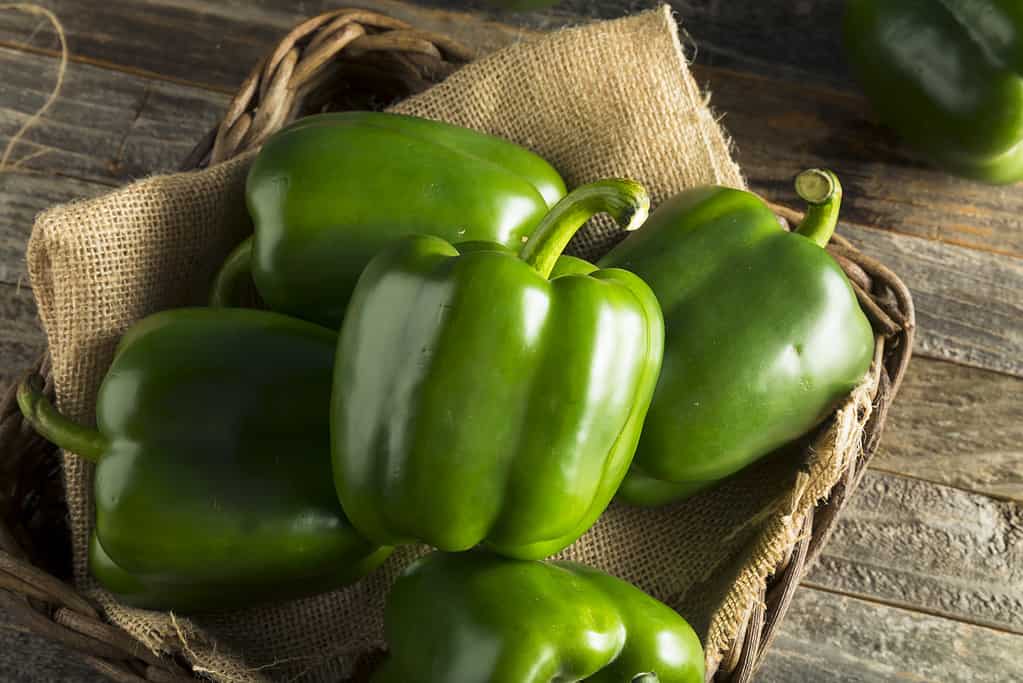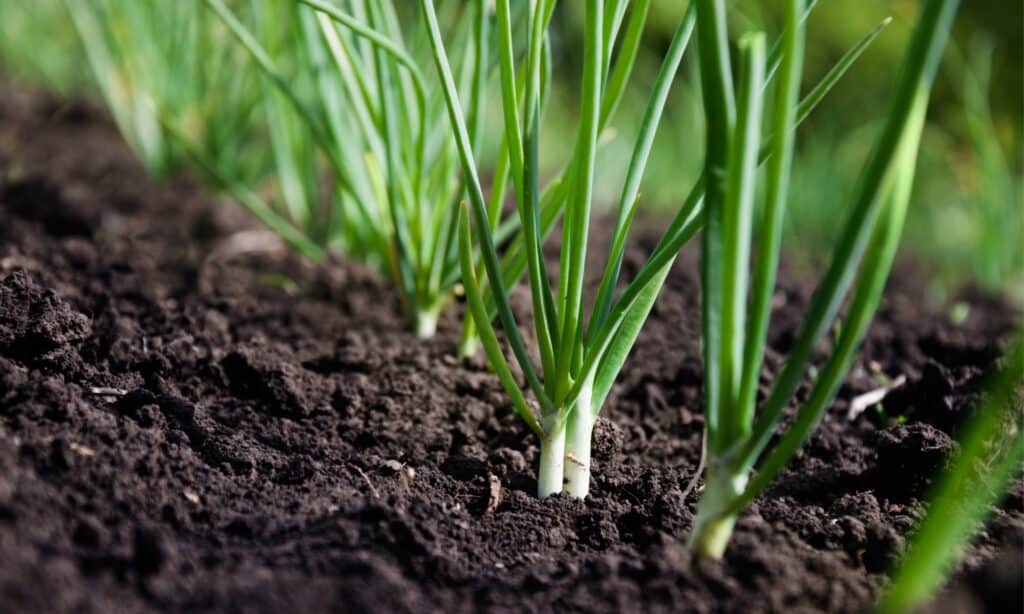Get ready to embark on a green and glorious journey through the world of vegetables that start with the letter G! From the garden to your plate, these green goodies pack a punch of nutrition and flavor that will leave your taste buds dancing with delight.
1. Garlic

Garlic grows well in hardiness zones 5 through 7.
©Carl.Salisbury/Shutterstock.com
It is a popular, pungent, and flavorful herbaceous plant widely valued for its culinary and medicinal properties. Native to Central Asia, garlic has been cultivated for over 5,000 years. Its distinctive appearance features white or purple bulbous cloves, encased in a papery skin, with green, slender leaves emerging from the top.
Beyond its culinary allure, garlic boasts several health benefits. It is renowned for its potential to boost the immune system, lower blood pressure, and reduce the risk of heart disease. Allicin, a compound released when garlic is crushed or chopped, is credited for many of these health advantages.
What makes garlic truly interesting is its multifaceted nature. It serves as both a beloved seasoning and a potent natural remedy. This duality has sparked scientific curiosity, leading to ongoing research into its various applications, such as its potential in cancer prevention and its antimicrobial properties.
2. Ginger

This vegetable grows in hardiness zone 8 and under.
©iStock.com/grafvision
Ginger is a remarkable spice and medicinal plant celebrated for its distinctive flavor and a wide range of health benefits. Native to Southeast Asia, ginger is a tropical plant characterized by its knobby, beige-colored rhizomes that shoot up green stalks and delicate yellow flowers. It’s a visually striking plant that has been cultivated for centuries.
The long cultural history of ginger is one of its most intriguing features. Because of its propensity to calm digestive problems, lower inflammation, and minimize motion sickness, it has been employed in ancient medical systems including Ayurveda and ancient Chinese Medicine. It ultimately expanded to other regions of the world after finding its way onto historic trade routes.
Ginger’s benefits extend beyond its culinary uses. It is revered for its anti-inflammatory and antioxidant properties, which can aid in relieving arthritis pain and reducing the risk of chronic diseases. Additionally, ginger has proven effective in treating nausea, making it a popular remedy for morning sickness during pregnancy and motion sickness.
Its spicy, slightly sweet taste adds depth to dishes ranging from curries to baked goods. It can be enjoyed in various forms, including fresh, dried, powdered, or as a fragrant oil.
What truly sets ginger apart is its versatility. Whether you’re sipping on ginger tea to ease an upset stomach or adding a zing to your stir-fry, it’s a spice that seamlessly transitions between medicinal and culinary worlds.
3. Green Beans

They can grow in hardiness zones 6 through 9.
©BreakingTheWalls/ via Getty Images
Green beans are another well-liked and healthy food that starts with G. These pods get their name because of their characteristic long, thin shape and vivid green hue. Their crisp texture and mild, somewhat sweet flavor have made them popular.
The history of green beans, which originated in Central and South America, is extensive. For thousands of years, indigenous peoples in these regions have been farming them. They become widely utilized in a variety of meals after fast gaining popularity all over the world.
The variety of ways they may be used in cooking is what makes green beans so intriguing. You may eat them raw in salads for a crunchy, refreshing snack, or prepare them in a variety of tasty dishes. Blanching, stir-frying, steaming, and roasting with spices are common preparations. Because of their versatility, they may be used in many different recipes.
It’s fitting that green beans should play a part in eco-friendly farming. They are simple to cultivate and use less water than many other types of crops. Their capacity to fix nitrogen in the soil has environmental benefits, as it improves soil quality and decreases the need for synthetic fertilizers.
4. Green Bell Pepper

Bell peppers grow in hardiness zones 3a to 11b.
©iStock.com/bhofack2
The next vegetable on our list of vegetables that start with G is none other than the versatile green bell pepper! These peppers are distinguished by their vivid green color and often have a blocky form with three or four lobes. They are renowned for their mild and somewhat bitter flavor, but they also come in a variety of hues when they ripen, including red, yellow, and orange.
Green bell peppers have a long, illustrious history as a native of Central and Mexico. Long before Christopher Columbus and other explorers brought them to Europe, they were grown by native peoples. Today, they are grown worldwide, thriving in warm climates.
Green bell peppers offer several health benefits. They are an excellent source of vitamin C, which supports the immune system, aids in collagen production, and acts as a powerful antioxidant. Additionally, they provide dietary fiber, aiding in digestion and promoting a feeling of fullness, which can be beneficial for weight management.
What makes green bell peppers interesting is their culinary versatility. They are delicious when eaten raw in salads, where they offer crunch and a mild flavor. They provide both taste and color to many different recipes when cooked, from stir-fries to stuffed peppers. Because of their versatility, they are frequently used in many different cuisines.
5. Green Onions

These thrive in hardiness zones 6 to 9.
©iStock.com/Zoya2222
Green onion, a herb or vegetable that starts with G, is a delicious complement to a wide variety of recipes. These onions, which have several other names, including scallions and spring onions, stand out visually. They have long, skinny stems that finish in little white bulbs. The green parts are lush and bright in color, while the white parts have a subtle onion taste.
Green onions, which originated in Asia, have been cultivated for thousands of years. Originating in China, its cultivation has now expanded around the globe. Due to their capacity to thrive in a variety of environments, they are now widely used in cooking.
Green onions’ crisp, onion-like taste makes them a popular garnish and condiment. If you find regular onions to be too strong of a flavor, these are a good alternative. In addition, their faint oniony flavor makes them an essential component in many popular Asian recipes.
Green onions also provide certain health advantages when consumed. Folate, vitamin K, and vitamin C are just some of the vitamins they offer. These vitamins are essential for proper cell division, immune system function, and bone health. In addition, the antioxidants included in green onions help mitigate the damage caused by oxidative stress.
They are a useful addition to any kitchen since they can be grown fast and simply in backyard gardens or indoor pots. If you plant the white bulbs in soil that drains well, they will keep sending up new leaves year after year.
6. Ginseng

Ginseng grows in hardiness zones 3 to 7.
©iStock.com/KirsanovV
Due to its distinctive root and alleged health benefits, ginseng is a well-known medicinal plant. It stands out because of its fleshy, forked root that is sometimes likened to the human figure. Asian ginseng and American ginseng are the two main varieties.
If you put a lot of time and effort into it, growing ginseng at home can be rewarding. Just keep in mind that ginseng thrives in temperate regions with lots of chilly, dark environments. Find a location in your yard or garden that has filtered or dappled light yet is protected from the scorching sun.
Ginseng flourishes on soil that is loamy in texture, well-draining, and slightly acidic (pH 5.0–6.0). To improve the soil’s fertility and ability to hold onto water, incorporate organic materials into it, such as compost or leaf litter.
The seeds used to cultivate most ginseng are best sown in the fall. The spacing between rows should be four to six inches, and the seeds should be buried about an inch deep. While seeds are germinating, keep the soil’s moisture level constant.
Mulch thickly with leaves or straw to maintain a constant moisture and temperature in the soil. This mimics forest floor conditions, which are favorable for the growth of wild ginseng. Keep animals away from your beds since they can be lured to the ginseng roots.
It’s critical to remember that ginseng grows very slowly and might take years to reach full maturity. Regular watering and insect control are required. Ginseng roots typically mature after five to six years and can be harvested. When harvesting, take care not to damage the roots. Before putting them away, wash and properly dry them.
7. Garbanzo Beans

Garbanzo beans do well in hardiness zones 3 to 9.
©innakreativ/Shutterstock.com
There are so many reasons to grow your garbanzo beans. By growing fresh garbanzo beans, you can enjoy this tasty bean without worrying about additional preservatives or storage requirements. Also, eating locally cultivated garbanzo beans is in line with living sustainably. You can lessen the environmental effect of large-scale farming and transportation by growing your food. It’s a win-win for the environment and you since it moves you closer to sustainability and reduces your carbon footprint.
It’s a smart decision financially as well. You’ll become less dependent on selections from the supermarket if your garbanzo bean harvest is thriving. This results in savings over time since you have a readily available source of these healthy legumes in your garden.
Let’s not forget taste! Garbanzo beans from your garden are unmatched. Your cultivated chickpeas have a delicious nutty and earthy flavor, unlike ones that have been sitting on supermarket shelves for who knows how long. Whether it’s salads, stews, or homemade hummus, they can improve your food.
Having your garbanzo beans at home also puts you in charge. If you opt for an organic method of growing them, they will be free from pesticides and other harmful substances. Your chickpeas will be as pure and natural as possible thanks to this.
And last, cultivating garbanzo beans may be a really rewarding gardening endeavor. It’s a chance to get in touch with nature, learn about plant growth, and develop your green thumb. Whether you garden alone or with family, it’s a fun and instructive experience.
Summary of Vegetables That Start With G + More
| # | Vegetables |
|---|---|
| 1 | Garlic |
| 2 | Ginger |
| 3 | Green Beans |
| 4 | Green Bell Pepper |
| 5 | Green Onions |
| 6 | Ginseng |
| 7 | Garbanzo Beans |
| 8 | Golden Beets |
| 9 | Groundnut |
| 10 | Gai Lan |
| 11 | Globe Artichoke |
| 12 | Greens |
| 13 | Gherkin |
| 14 | Galangal |
| 15 | Ground Cherry |
| 16 | Gourd |
| 17 | Garden Rocket |
| 18 | Gongura |
| 19 | Green Amaranth |
| 20 | Gem Squash |
Thank you for reading! Have some feedback for us? Contact the AZ Animals editorial team.








